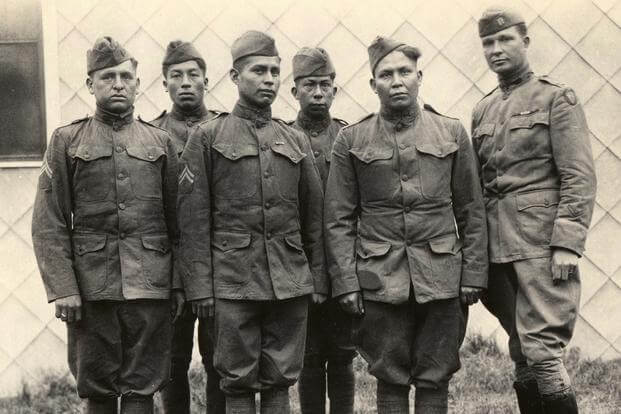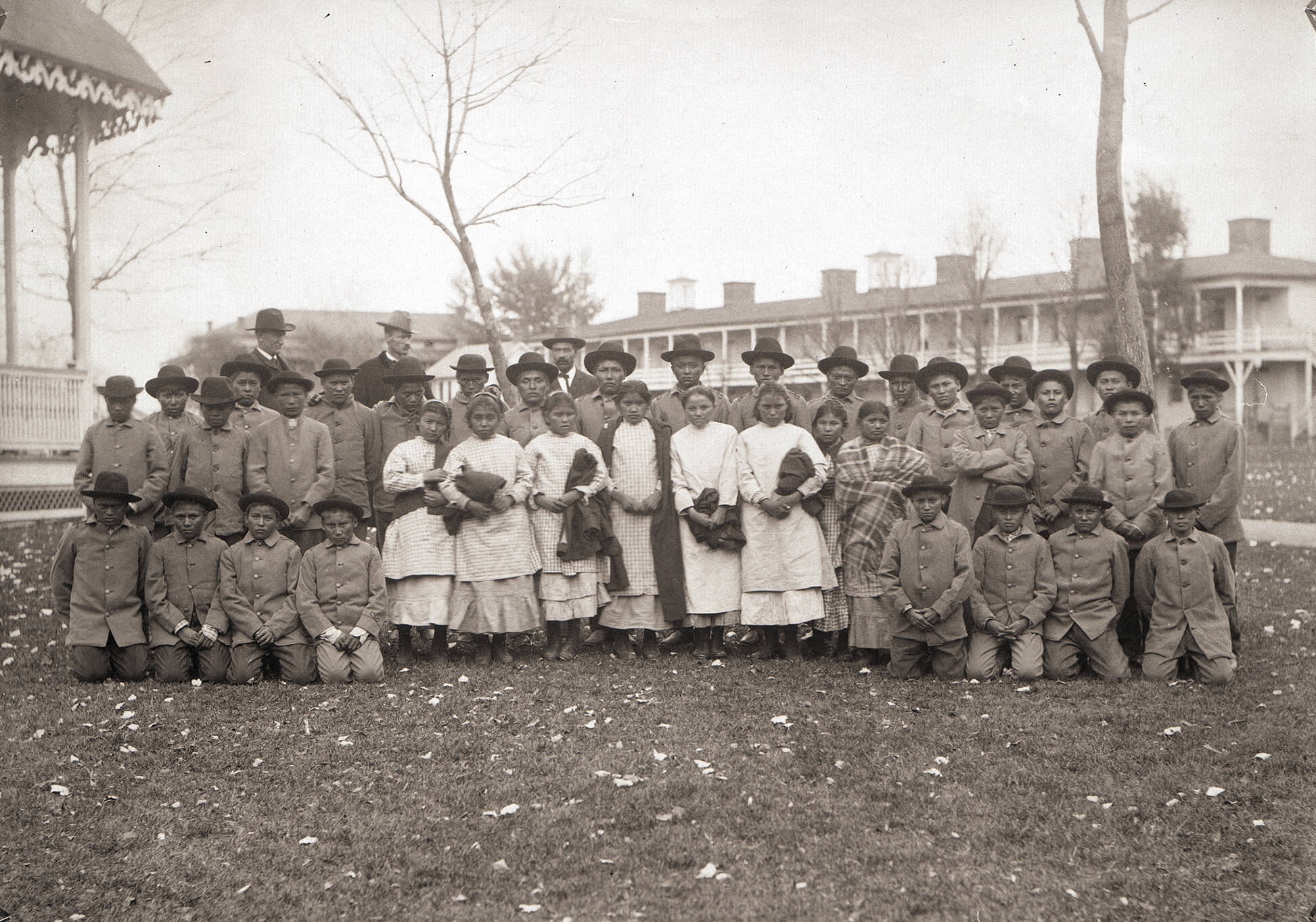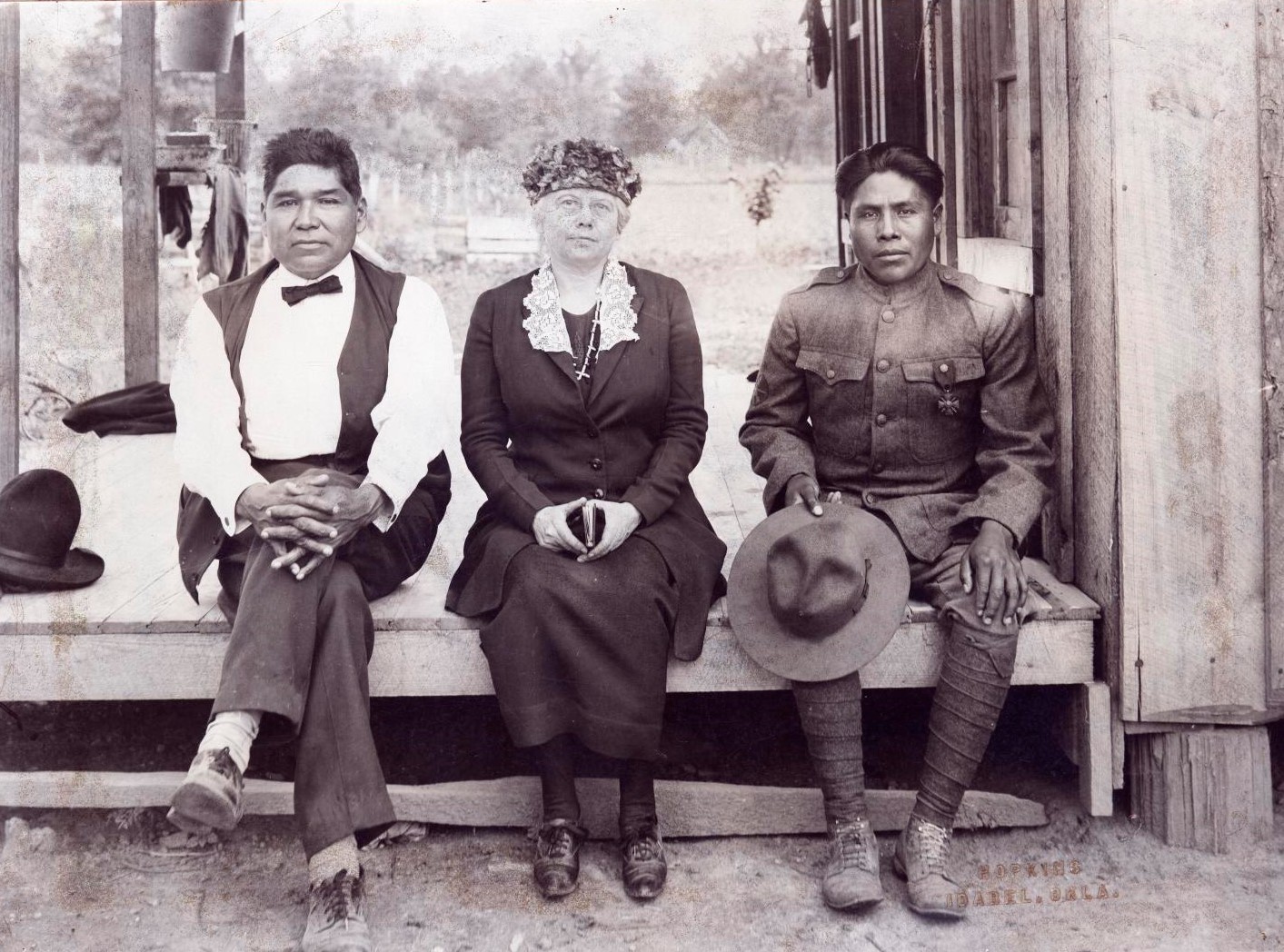
A squad of Choctaw Code Talkers in Camp Merritt, New Jersey. From left: Cpl. Solomon Bond Louis, Pvt. Mitchell Bobb, Cpl. James Edwards, Cpl. Calvin Wilson, Pvt. George (James) Davenport, Cpt. Elijah W. Horner. Photographer: Joseph K. Dixon | The Indiana University Museum of Archaeology and Anthropology
In the words of W. Richard West, Jr., the founding director of the National Museum of the American Indian, “Language is central to cultural identity. It is the code containing the subtleties and secrets of cultural life. In many ways, language determines thought.” In 1918, U.S. Army officials strategized a way to use Native languages as a code after hearing Indigenous Soldiers talking in their language. They hoped messages coded in Native languages would stop the possibility of enemy interception. The Native Code Talkers of World War I used their languages to aid the war effort at a time when there was also a push to strip away Native cultural identities and languages.
Indigenous Soldiers at War
Native American military involvement traces back to the American Revolution and continues today. Many tribes sided with the British during the Revolution and the War of 1812 to support their established trading partnerships. Some tribes, like the Oneida or Tuscarora, sided with the colonists due to their proximity to colonial towns. The goal of all tribes was to protect their lands from continued colonization. This motivation carried over to the estimated 3,503 Native Soldiers who fought in the Civil War. Mark Hirsch, the co-author of the book “Why We Serve, Native Americans in the United States Armed Forces,” poses an important question: “Why would (Native peoples) fight for America which has a long history of colonizing, massacring, and breaking treaty promises? Given that history, why is it that we have this remarkable legacy of Native American military service?”
As there is not one Indigenous experience, there is not a sole reason why Native peoples choose to enlist. Some historians have tied Native American military service to the myth of the warrior tradition. The myth says that all Native peoples have an “innate warrior ability.” While some tribes do have their own warrior tradition, others follow more pacifistic customs.
The military provides some Soldiers the opportunity to create a better life for themselves and their families. Many Indigenous Soldiers see their service as a way to protect their homelands, while others join for economic opportunities. There are a multitude of reasons why Native Soldiers join the military but Kevin Gover, previous director of the National Museum of the American Indian, said, “they are acknowledging the mistreatment their tribes have suffered at the hands of the United States, yet they still imagine a different and better tribal life in the future.”
Erasure of Native Cultures

A group of Chiricahua Apache children who recently arrived at the Carlisle Indian Industrial School. Photographer: John N. Choate | National Museum of the American Indian
In 1879, Brig. Gen. Richard Pratt founded the first Indian boarding school, the Carlisle Indian Industrial School, in Carlisle, Pennsylvania. Pratt founded the school in the former barracks where the Army trained the U.S. Cavalry. The school was administered through the Department of the Interior, Office of Indian Affairs. In a speech about the creation of boarding schools, Pratt said , “A great general has said that the only good Indian is a dead one … In a sense, I agree with the sentiment, but only in this: that all the Indian there is in the race should be dead. Kill the Indian in him, and save the man.” The school’s goals followed the sentiment of Pratt’s message: remove the Indigenous identity and replace it with an American one. Soon 100 Indian boarding schools spread across the country, both on and off Indian reservations. Armed guards and police forced some children into the schools.
The boarding schools stripped students of all things that could connect them to their Native lives. One of their biggest targets for eradication was Native language. Schools gave all students English names and forced them to speak only English. At some of the schools, students heard speaking their Native languages received physical punishments. Boarding schools limited student contact with their family and other tribal members, if they allowed contact at all. Isolation from their family and tribes was believed to help assimilate Native students into American culture. Boarding schools also restricted Native religious practices. The schools often operated in a militaristic style complete with short haircuts, uniforms, and unit organizations. Many of the Army’s Code Talkers attended these boarding schools and recalled the schools punishing them for speaking their languages. Some later said that the military feel of the schools helped smooth their transition into military life.
World War I
When the United States entered World War I in 1917, 12,000 Native Americans volunteered for military service even while one-third of the Native population was not recognized as American citizens by the government. Many Native Soldiers believed that their efforts in the war would prove their patriotism and help achieve citizenship for all Native peoples. Some Native Soldiers joined to protect their tribes and the United States. Others joined to gain respect as warriors or to seek a better life for themselves and their families. Native Soldiers had no idea that their Native languages would play an important role in the Great War.
In late September 1918, the 30th Infantry Division realized a dangerous flaw in U.S. Army signal communications: the messages were not secret. The Germans quickly intercepted and translated messages sent in plain English. The enemy used the messages to discover Allied force’s locations and gain an advantage on the battlefield. Upon this discovery, a group of Eastern Band Cherokee used their Native language to communicate for the 105th Field Artillery Battalion, 30th Infantry Division. The Cherokee Soldiers successfully delivered messages between Allied troops without interception by the enemy. The Cherokee Code Talkers continued their work until the end of the war. The Eastern Band Cherokees’ work during the Second Battle of the Somme marks them as the earliest documented use of Native Code Talkers by the U.S. Army. However, anecdotal evidence suggests the Ho-Chunk were the first to use their Native language in code in early 1918.
The most well-documented group of Code Talkers from World War I are the Choctaw Soldiers from the 142nd and 143rd Infantries. Col. Alfred Wainwright Bloor, commander of the 142nd Infantry, 36th Infantry Division, sent a message to headquarters saying, “it was remembered that the regiment possessed a company of Indians. They spoke twenty-six different languages or dialects, only four or five of which were ever written.” Bloor had Choctaw Soldiers move troops and coordinate attacks from Oct. 26 to 28, 1918. The Choctaw coordinated an artillery attack that took the Germans by surprise. This surprise attack resulted in a much-needed victory for the 36th Infantry Division. There were a total of 18 Code Talkers, 16 in the 142nd Infantry Regiment and two in the 143rd.
After Bloor’s successful attack, the Code Talkers quickly developed an official code. Many military words could not be directly translated from Native languages. James Edwards, one of the Choctaw Code Talkers, helped create the code used in their communications. For example, Tuska chipota means “warrior soldier” in the Chahta Anumpa or the Choctaw language. Code Talkers shortened Tuska chipota in code to represent “Soldier” when used in messages. The word for battalion was “twice big group,” “fast shooting gun” was a machine gun, and “big gun” meant field artillery. While the Choctaw Soldiers are the most documented group of the World War I Code Talkers, the Army used nine tribal languages during the war. The Cheyenne, Cherokee, Comanche, Ho-Chunk, Osage, and Yankton Sioux also provided Code Talkers during World War I.

John Golombie, Czarina Colbert Conlan, and Joseph Oklahombi at Oklahombi’s home near Wright City, Oklahoma, May 12, 1921. Photographer: Hopkins | Oklahoma Historical Society
Native Code Talkers sent communications between Soldiers, but they also fought valiantly. Newspapers across the country hailed Pvt. Joseph Oklahombi of Company D, 1st Battalion, 141st Regiment, a Choctaw Code Talker, as one of Oklahoma’s greatest war heroes. In October 1918, Oklahombi and his company were cut off behind enemy lines when they came across a German machine gun nest. Oklahombi and his 23 fellow Soldiers rushed to the enemy’s position. The Soldiers captured a German machine gun which they turned on the enemy. They pinned down the enemy for four days before 171 German soldiers eventually surrendered. Oklahombi was awarded the World War I Victory Medal and a Silver Citation Star for his bravery. France even awarded him the Croix de Guerre.
The Legacy
The Code Talkers were so successful in World War I that the Germans saw them as a serious threat to their future war efforts. In the 1930s, Germany sent spies and agitators to sabotage future Code Talkers and limit enlistment of Native Americans. German agents visited Native nations disguised as writers looking to learn about their languages. Propagandists, such as German anthropologist Dr. Colin Ross, argued that Native peoples should not sign up for the draft. He visited Native American reservations to gather information for use in the German propaganda ministry. Ross wrote articles and books encouraging Native Americans to rebel against the government. American groups with German sympathies such as the Silver Shirts and German American Bund also attempted to gain Native supporters. The German American Bund financed campaigns to incite Natives in Montana and the Dakotas against the draft in 1939 and 1940. Germany’s actions against Native enlistment and the Code Talkers eventually failed. Pro-German propaganda ignored the progress America had made in rectifying some Native issues such as poverty and autonomy. Instead, Native communities joined in droves to fight in World War II.
Due to the Code Talkers’ success in World War I, the U.S. Army, Navy, and Marines continued and expanded the program to include more tribes in World War II. The number of participating tribes increased from 7 to 34. The most well-known were the Diné, also known as the Navajo, who successfully transmitted messages in the Pacific Theater by using the Diné Bizaad, or Diné language. Philip Johnston, a white World War I veteran who spoke Navajo, suggested the Marine Corps employ Navajo as Code Talkers. Johnston said that the Navajo language was, “the only Indian language not thoroughly studied by Axis [German] agents during the past two decades” because the language was never written down up to that point.
Despite their success and show of patriotism, it still took years for Native communities to be recognized as citizens. After World War I, in 1924, Congress granted citizenship to all Native Americans in part because of Native enlistment during World War I. Even with that step forward, it was not until 1975 that tribes gained full civil rights with the passing of the Indian Self-Determination and Education Assistance Act. This act allowed Native nations more autonomy and to take responsibility for operating the programs and services traditionally run by the Department of the Interior. Three years later Congress passed the American Indian Religious Freedom Act. The act recognized the many ways that the government had suppressed Native American religion. Under the new act, Native people could now exercise their religion freely under the First Amendment of the Constitution. The government honored the Navajo Code Talkers for their service in 2000. In 2008, Congress recognized all other Native Code Talkers with a Congressional Gold Medal. A Congressional Gold Medal awarded to the Comanche Nation is on display in the Army and Society Gallery in the National Museum of the United States Army.
While boarding schools and other institutions suppressed Native culture and ways of life, their unique languages proved to be a vital asset in both World Wars. The Code Talkers of World War I were in the right place at the right time to serve in a unique combat role. Their skills were a threat to their enemies, and their codes were a guarded secret.
Native Soldiers continue to fight for a nation that has not consistently fought for them. The Code Talkers’ legacy is seen in the long-standing commitment of Native servicemen and women. Nineteen percent of all Native Americans have served in the Armed Forces since September 11, 2001, the highest percentage of any specific ethnic group. As of 2023, there are 574 federally recognized tribes in America and while all have different values and beliefs, military service continues to be one constant.
Jordan Ginder
Graduate Historic Research Intern
Ellora Larsen
Education Specialist
Sources
“American Indian Code Talkers.” The National World War II Museum. Accessed July 7, 2021. https://www.nationalww2museum.org/war/articles/american-indian-code-talkers.
Bear, Charla. “American Indian Boarding Schools Haunt Many.” NPR, May 12, 2008. https://www.npr.org/templates/story/story.php?storyId=16516865.
Bernstein, Alison Ricky. “Walking in Two Worlds: American Indians and World War Two.” PhD diss., Columbia University, 1986.
“Choctaw Indian Code Talkers of World War I.” Texas Military Forces Museum. Accessed March 1, 2021. http://www.texasmilitaryforcesmuseum.org/choctaw/codetalkers.htm.
“Code Talkers.” Choctaw Nation. Accessed March 1, 2021. https://www.choctawnation.com/history-culture/people/code-talkers.
“Joseph Oklahombi: Choctaw, Doughboy, Code Talker & Mighty Warrior.” WorldWarI.com. Accessed October 22, 2021. http://www.worldwar1.com/dbc/j_oklah.htm.
Morgan, Thomas D. “Native Americans in World War II.” Army History 35, (Fall 1995): 22-27. https://www.jstor.org/stable/26304400.
Meadows, William C. The First Code Talkers: Native American Communicators in World War I. Norman: University of Oklahoma Press, 2021.
Meadows, William C. “Native American Code Talkers of World War I.” The United States World War One Centennial Commission. Accessed July 7, 2021. https://www.worldwar1centennial.org/index.php/american-indians-in-ww1-code-talkers.html.
“Native Americans and Freedom of Religion.” National Geographic, April 27, 2020. https://www.nationalgeographic.org/article/native-americans-and-freedom-religion/.
“Native Words, Native Warriors.” Smithsonian National Museum of the American Indian. Accessed March 1, 2021. https://americanindian.si.edu/nk360/code-talkers.
“Native Americans in the U.S. Army.” Center of Military History. Last modified January 31, 2021. https://history.army.mil/html/topics/natam/index.html.
Pember, Mary Annette. “Death by Civilization.” Atlantic, March 8, 2019. https://www.theatlantic.com/education/archive/2019/03/traumatic-legacy-indian-boarding-schools/584293/.
Riseman, Noah. Defending Whose Country?: Indigenous Soldiers in the Pacific War. Lincoln: University of Nebraska Press, 2012. https://www.jstor.org/stable/j.ctt1ddr6qd.
Townsend, Kenneth William. “At the Crossroads: Native Americans and World War II.” PhD diss., University of North Carolina, 1991.
“What Does It Mean to Be a Warrior?” PBS. Accessed July 7, 2021. https://www.pbs.org/wned/warrior-tradition/features/what-does-it-mean-to-be-a-warrior/.
Winterman, Denise. “World War One: The Original Code Talkers.” BBC News Magazine, May 18, 2014. https://www.bbc.com/news/magazine-26963624.
